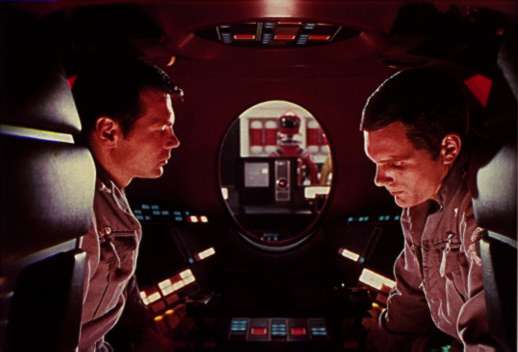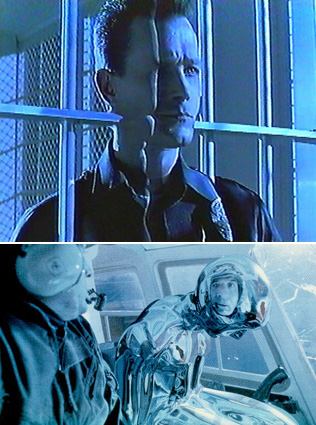
What's Your Angle?: All About Composition
Ignore the technology of optics, photography, and motion pictures for the moment. We'll get to that in Lesson 3. For the time being, let's concentrate on the elements of the image that do not depend on technology¡ªthose elements that could have been utilized by the cave painters at Lascaux 30,000 years ago.
When an artist decides to create an image of the real world, he or she chooses a point of view and a frame―in other words, a composition. Composition refers to the arrangement of the elements in a picture or frame, their relationship (both in space and meaning) to one another and to the camera, and the artistic form that they create together. The composition has an axis of depth, too: there is a foreground, a middle ground, and a background. Some of the real scene will be in the frame, some will not. We will be looking at the scene from a low angle, a level angle, or a high angle. The elements of the scene that we see will relate to each other in various ways: the composition will be balanced, or it will be off-center; it will be tight or there will be space around the basic elements. If it's a "moving picture," the subjects will either be moving or still, just as the camera will either be moving or it will not be.
There is a simple calculus for the composition of a frame. When you are looking at a movie image (or a painting, for that matter), think about these elements. What is in the scene? Just as importantly, what is not in the scene? Are we looking up (which imputes power to the figures in the scene) or are we looking down (which imputes power to us, the observers). For example, a simple shot of a man on-screen, if taken from above, could imply that he has the weight of the world on his shoulders. That same man, if viewed from below, could seem inspired and ready to rise above his troubles.
As you can see, simple composition choices made by the artist can have complex implications on the final result. Different ways of framing, arranging, or looking at elements can make for drastically different shots, even if those shots are composed of the same core elements. What's more, these choices can affect the viewer's interpretation in drastically different ways.
 |
||
| To Kubrick, composition gave a shot at least as much meaning as the actions the shot pictured. Notice HAL in the background, observing the "private" conversation (and reading lips). | ||
Our viewing assignment for this lesson is a highly stylized and abstract film that makes it easy for you to study and discuss angle and composition. Director Stanley Kubrick's 2001: A Space Odyssey is a rich collection of thoughtfully designed frames. And the vast majority of them carry a significant freight of symbolic meaning. In other words, the action that takes place in the shot is often not as important as the design of the shot, or the meaning or message behind it.
For example, there is a scene in which Dave and his fellow astronaut, suspecting that HAL is part of the problem, not the solution, isolate themselves in one of the pods. The dialogue here isn't especially important. What is more important is that we see that HAL can see them¡ªand we suspect that he can read their lips!
Kubrick was a leader of the generation of the 1960s when filmmakers first revealed their intellectual understanding of their art. It was the beginning of postmodernism, an attitude in which you are aware of the art you are doing and you share that awareness with your audience. When we discuss this film, we'll have the opportunity to talk about hundreds of other remarkable compositions and unusual angles. Watch for them!
Digital vs. Analog: An Introduction
 |
||||
| T2 upped the ante on special effects, digitally blending the real world with the imaginary and causing a mainstream audience to take notice. | ||||
As we noted in a previous section, the digital revolution doubled the art of the image. For thousands of years, during the second stage of the evolution of human media, the image that you saw was obviously an "artist's conception." Then, for a brief period of 150 years, when you saw a photograph you could pretty well trust it as vouching for reality. (Yes, there were photography "tricks"―but for the most part, what you saw was real.) Once the image was digitized, however, there was no way to be sure that what you saw ever existed. In the digital world, the image quality of a truthful shot is often no better than the image quality of an imaginary shot. This revolution was first evident in feature films with the release of Terminator 2: Judgment Day.
Our subject film for this lesson, 2001, was praised at great length for its special effects. None of them were accomplished digitally. All were analog tricks; most under the guidance of special photographic effects supervisor Douglas Trumbull, who had to invent a prodigious variety of machines and processes to accomplish shots like the trip at the end of the film.
It's hard for a new digital generation to appreciate how ingenious these analog devices were. But 2001 set the style for a generation of special-effects films that lasted until the digital techniques matured in the late 1990s. Indeed, a majority of the tricks accomplished digitally these days owe their origin to the analog inventions of 2001.
So then, what's the difference between analog and digital?
Perhaps the best way to understand the difference between old-fashioned analog systems and the new method of digital recording is to take a look at a simple example: sound recording. Vinyl LPs are analog; CDs are digital. Both are discs that revolve under a sensor. For the LP, it's a diamond-tipped stylus that rides in a groove. For the CD, it's a finely focused laser beam that reflects off the polycarbonate plastic.
If you looked at an LP under a microscope, you'd see that the groove has lots of squiggles. As the sound gets louder, the squiggles get wider. As the sound gets softer, they get narrower. As the pitch increases, the squiggles get closer together; as it decreases, they get farther apart. There is a directly analogous relationship between the sound wave and the representation of it. If you superimposed an image of the sound wave over an image of the groove, they would match.
If you looked at the CD under the microscope, however, you'd see a pattern that is quite different. There is no variation in the width of the track, no variation in the frequency of the track; just an endless series of "pits" and "lands," ons and offs, 1s and 0s. Either the laser beam is reflected or it is not―there is no in-between. The 1s and 0s of the binary code represent numbers (that's why it's called digital) and the numbers represent levels of sound. On a normal CD, there are 44,100 of these numbers rushing past the laser every second. Your CD player has to read and collect all these numbers, then re-create an analog waveform from them to drive your speakers. That's an awful lot of work. (And for video, multiply the numbers and the work by a factor of 10,000!)
But there's a terrific advantage to doing it. It's clean, it doesn't degrade (no matter how many times it is copied), and―most importantly―once the sound or image is digitized, it is infinitely manipulable. Want to change red to green? No problem: just search for red and replace it with green. Want to turn your superhero into a steel trap? Not much more of a problem:Just write the program.
Throughout this course, we'll be talking mainly about the physical-chemical analog world of film rather than the new digital world. There are two important reasons for this focus:
In addition to being a tour de force of shot composition, 2001 is a clarion for digital film. The special effects were so prodigious that a standard was set that would not be transcended until the digital age (by abernathy). It would take another 25 years for it to become a reality, but the idea had been planted.
Discussion
Please post your responses to the following questions on the class message board.